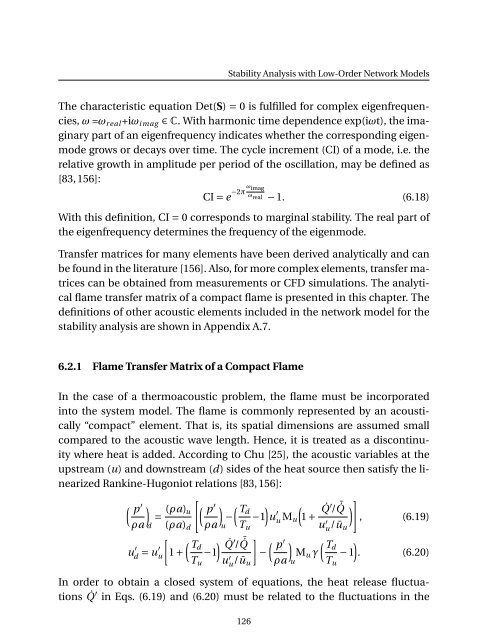Numerical Simulation of the Dynamics of Turbulent Swirling Flames
Numerical Simulation of the Dynamics of Turbulent Swirling Flames
Numerical Simulation of the Dynamics of Turbulent Swirling Flames
Create successful ePaper yourself
Turn your PDF publications into a flip-book with our unique Google optimized e-Paper software.
Stability Analysis with Low-Order Network Models<br />
The characteristic equation Det(S) = 0 is fulfilled for complex eigenfrequencies,<br />
ω =ω r eal +iω i mag ∈ C. With harmonic time dependence exp(iωt), <strong>the</strong> imaginary<br />
part <strong>of</strong> an eigenfrequency indicates whe<strong>the</strong>r <strong>the</strong> corresponding eigenmode<br />
grows or decays over time. The cycle increment (CI) <strong>of</strong> a mode, i.e. <strong>the</strong><br />
relative growth in amplitude per period <strong>of</strong> <strong>the</strong> oscillation, may be defined as<br />
[83, 156]:<br />
CI = e −2π ω imag<br />
ω real − 1. (6.18)<br />
With this definition, CI = 0 corresponds to marginal stability. The real part <strong>of</strong><br />
<strong>the</strong> eigenfrequency determines <strong>the</strong> frequency <strong>of</strong> <strong>the</strong> eigenmode.<br />
Transfer matrices for many elements have been derived analytically and can<br />
be found in <strong>the</strong> literature [156]. Also, for more complex elements, transfer matrices<br />
can be obtained from measurements or CFD simulations. The analytical<br />
flame transfer matrix <strong>of</strong> a compact flame is presented in this chapter. The<br />
definitions <strong>of</strong> o<strong>the</strong>r acoustic elements included in <strong>the</strong> network model for <strong>the</strong><br />
stability analysis are shown in Appendix A.7.<br />
6.2.1 Flame Transfer Matrix <strong>of</strong> a Compact Flame<br />
In <strong>the</strong> case <strong>of</strong> a <strong>the</strong>rmoacoustic problem, <strong>the</strong> flame must be incorporated<br />
into <strong>the</strong> system model. The flame is commonly represented by an acoustically<br />
“compact” element. That is, its spatial dimensions are assumed small<br />
compared to <strong>the</strong> acoustic wave length. Hence, it is treated as a discontinuity<br />
where heat is added. According to Chu [25], <strong>the</strong> acoustic variables at <strong>the</strong><br />
upstream (u) and downstream (d) sides <strong>of</strong> <strong>the</strong> heat source <strong>the</strong>n satisfy <strong>the</strong> linearized<br />
Rankine-Hugoniot relations [83, 156]:<br />
[<br />
( p<br />
′ )<br />
= (ρa) (<br />
u p<br />
′ )<br />
ρa d (ρa) d ρa<br />
[<br />
u ′ d = u′ u<br />
1 +<br />
u<br />
( Td<br />
−<br />
( Td<br />
) ˙Q ′ / ¯˙Q −1<br />
T u u u ′ /ū u<br />
)<br />
−1 u ′ u<br />
T M u<br />
u<br />
]<br />
(<br />
1 + ˙Q ′ / ¯˙Q ) ]<br />
u u ′ /ū , (6.19)<br />
u<br />
( p<br />
′ ) ( Td<br />
)<br />
− M u γ − 1 . (6.20)<br />
ρa u T u<br />
In order to obtain a closed system <strong>of</strong> equations, <strong>the</strong> heat release fluctuations<br />
˙Q ′ in Eqs. (6.19) and (6.20) must be related to <strong>the</strong> fluctuations in <strong>the</strong><br />
126
















